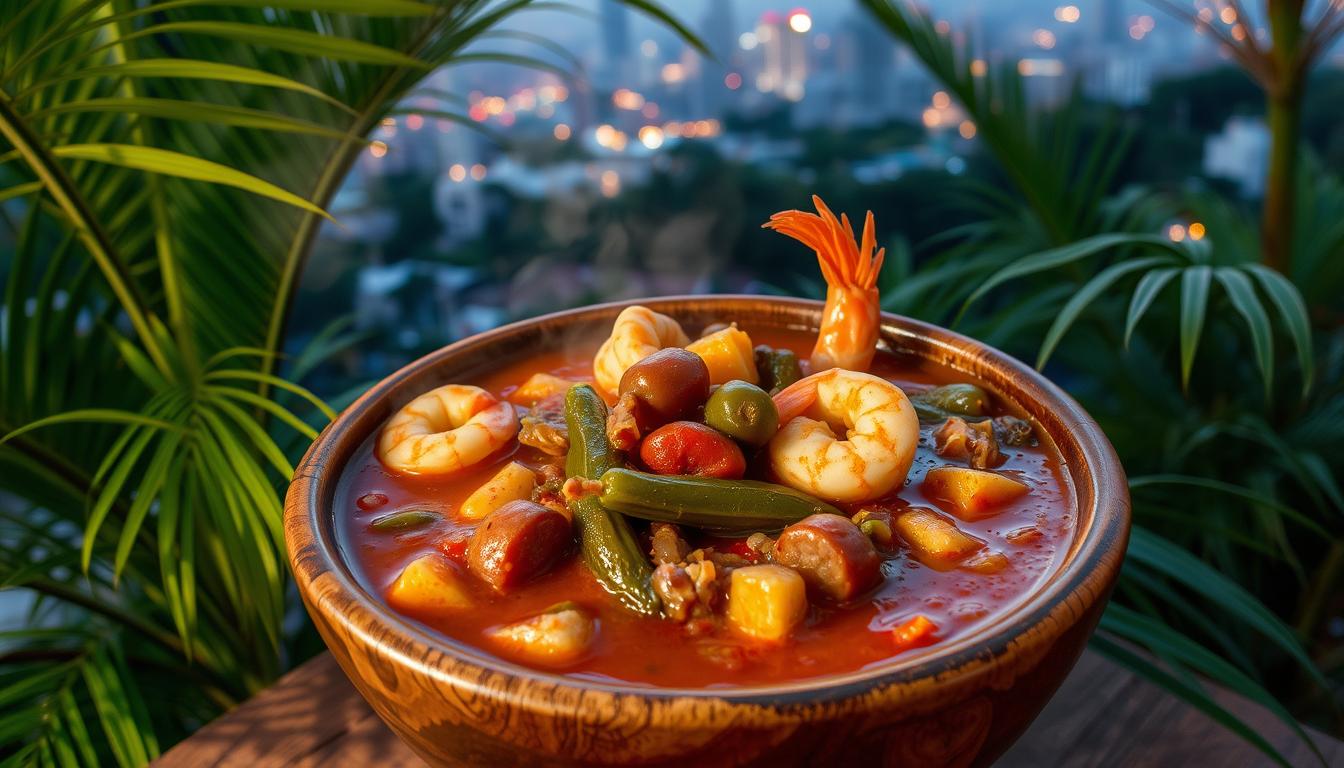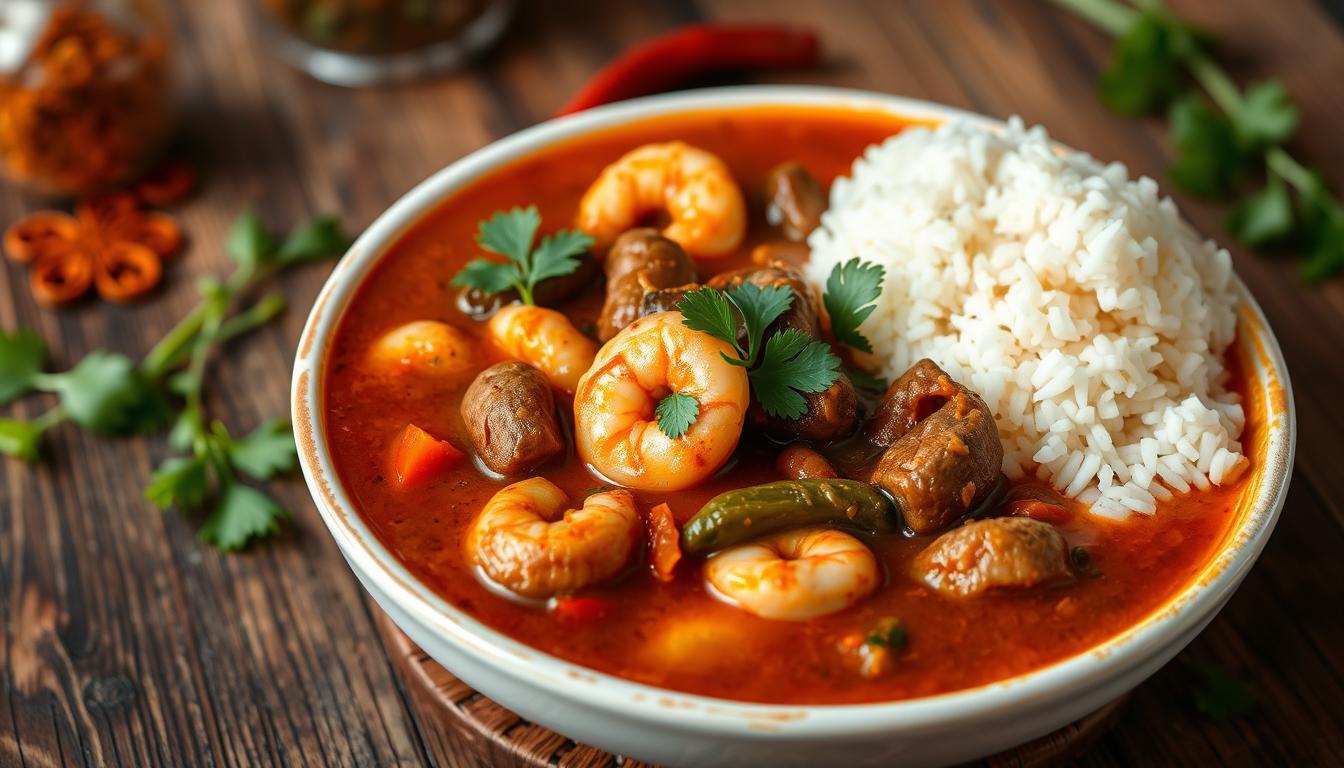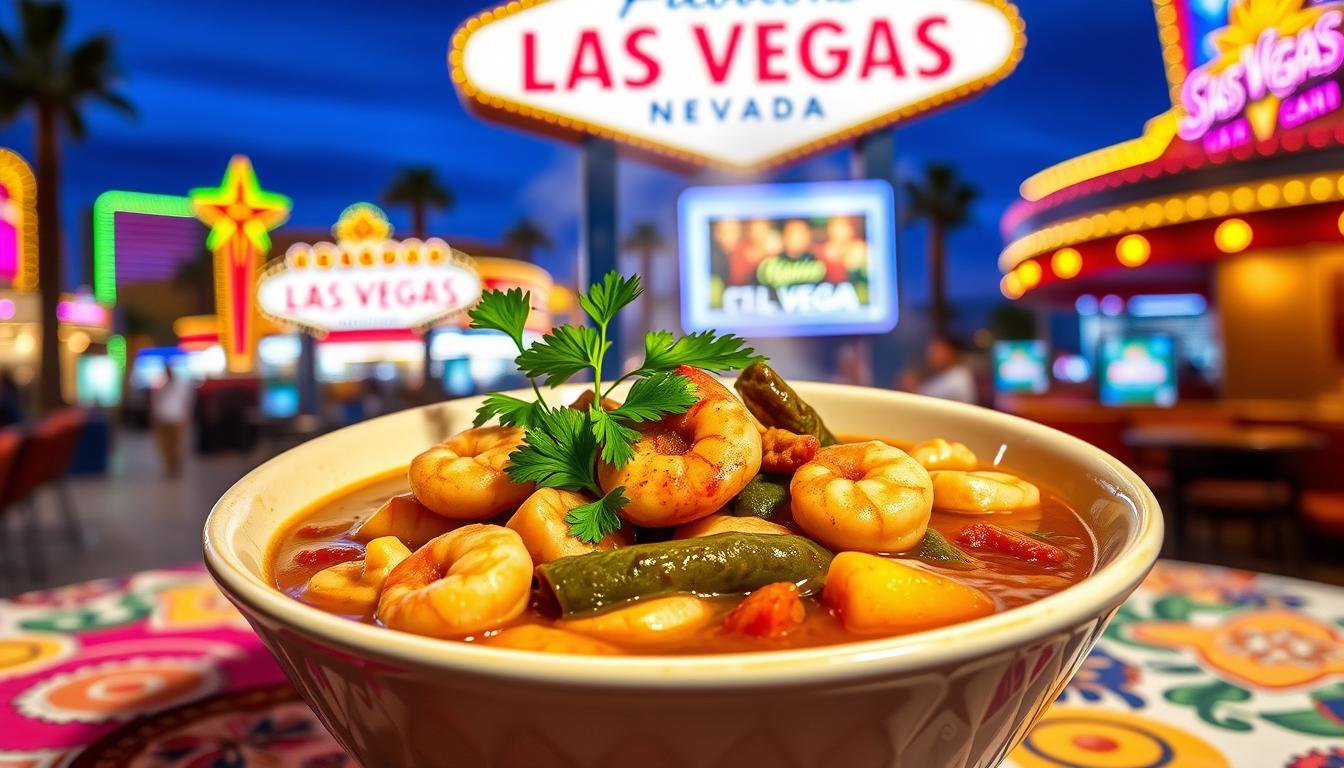Did you know a hearty serving of gumbo has about 558 calories? It’s a fulfilling dish that shows off Louisiana’s rich culinary tradition. This classic gumbo with okra recipe is more than just a meal. It’s a flavorful journey that connects you to the diverse cultural heritage of the region.
This authentic gumbo recipe is easy to make and perfect for sharing. Whether you’re hosting a gathering or enjoying a cozy night in, it’s ideal. The blend of spices brings out the best flavors from the ingredients, making it a dish you can enjoy any time of the year.
Coating tender chicken and savory sausage in a rich roux, along with the essential vegetable medley known as the Holy Trinity, makes this gumbo special. You’ll see why it’s often called the best gumbo recipe with okra. Get ready to dive into a culinary experience that satisfies your taste buds and honors Louisiana’s age-old traditions.
Understanding Gumbo: A Culinary Tradition
Gumbo is deeply rooted in Louisiana’s culinary history. It comes from a mix of West African, Native American, and European cultures. The first gumbo mention was in 1764 in New Orleans. Over time, it became a family and community tradition, symbolizing Louisiana’s culture.
The Origins of Gumbo
The gumbo history is fascinating. The first written records were in the 19th century. Okra, a key ingredient, was used from the start. By the mid-1800s, New Orleans loved gumbo, with ads for okra seeds.
Recipes from that time show how okra was essential. This highlights its importance in gumbo’s early days.
Cultural Significance in Louisiana
Gumbo is more than food; it’s a cultural symbol in Louisiana. It brings people together at social events and family gatherings. It’s a dish that breaks down social barriers, showing the rich gumbo community.
There are many gumbo types, like Cajun and Creole. Each tells a story of Louisiana’s heritage. They show the unique flavors and traditions that make gumbo special.
| Era | Key Developments |
|---|---|
| 1764 | First known reference to gumbo in New Orleans. |
| 1840s | Newspaper ads offered seeds for “Okra or Gombo,” highlighting its popularity. |
| 1803-1804 | First documented references to gumbo appear. |
| 1885 | Lafcadio Hearn’s *La Cuisine Creole* includes various gumbo recipes. |
| 1901 | The *Picayune’s Creole Cookbook* features crab, shrimp, and chicken gumbo variations. |
Key Ingredients in Gumbo with Okra Recipe
To make a tasty gumbo with okra, you need the right ingredients. Choose quality proteins, essential vegetables, and thickening agents. This mix will make your chicken or sausage gumbo unforgettable.
Main Proteins: Chicken and Sausage
Use tender chicken thighs for their juiciness and flavorful sausage like andouille. This combo gives your gumbo a rich taste. It makes every spoonful better.
The Essential Vegetables: The Holy Trinity
The Holy Trinity of bell peppers, onions, and celery is key. They add aromatic flavors and a nice texture. These veggies blend well with your proteins, making the gumbo flavorful.
Thickening Agents: Okra and Roux
Okra thickens the gumbo and adds flavor. It cooks down to a smooth texture. The roux, made from flour and fat, also thickens the gumbo. Together, they make the gumbo hearty and comforting.
| Ingredient | Amount | Cooking Time | Calories per Serving |
|---|---|---|---|
| Chicken (thighs) | As desired | Varies | 29g |
| Sausage (andouille) | As desired | Varies | 22g |
| Okra | 1 pound | 25-30 minutes | 4g |
| Roux (vegetable oil & butter) | 3 tbsp oil, 4 tbsp butter | 30 minutes | N/A |
| Other Vegetables (Holy Trinity) | Bell peppers, onions, celery | 5-8 minutes after roux | N/A |
How to Make the Best Gumbo with Okra
Making a tasty gumbo with okra needs careful steps and attention. With the right gumbo cooking tips, you can enjoy a dish that warms your heart. We’ll look at each step, from making the perfect roux to adjusting spices.
Step-by-Step Cooking Instructions
Begin by browning proteins like smoked andouille sausage and shrimp in a big pot. Let the sausage get fat and flavor. Then, make a perfect roux by adding flour and oil slowly, stirring all the time. Aim for a dark chocolate color, which takes about 25 to 30 minutes.
After the roux is done, add the Holy Trinity—bell peppers, celery, and onions—and 12 ounces of sliced okra. Let these soften before adding 3 1/2 cups of shrimp stock. Simmer for about 45 minutes to blend the flavors.
Tips for the Perfect Roux
For a great roux, follow these tips to avoid burning:
- Use a heavy-bottomed pot that retains heat evenly.
- Maintain medium heat to control the cooking process.
- Stir constantly to prevent clumps and to achieve a consistent color.
- Be patient; rushing the roux can lead to a lighter color and less flavor.
Adjusting Spice Level to Your Preference
Your gumbo can be as spicy or mild as you prefer. Start with traditional spices like cayenne pepper or paprika. For a spicy gumbo, add hot sauce or diced peppers while simmering. Mix well and taste often, as spice adjustments can change the dish a lot.
| Ingredient | Amount |
|---|---|
| Okra | 12 ounces, sliced 1/2 inch thick |
| Shrimp | 1 1/2 pounds, shelled and deveined |
| Smoked Andouille Sausage | 11 or 12 ounces, sliced 1/4 inch thick |
| Shrimp Stock | 3 1/2 cups |
| Water | 7 cups |
| Dried Shrimp | 3/4 to 1 ounce |
Exploring Authentic Gumbo Recipes
Gumbo is a beloved dish in Louisiana, showing its rich cultural heritage. There are two main styles: Cajun gumbo and Creole gumbo. Each style has its own unique taste, making the dish special in different ways. Knowing the difference between Cajun and Creole gumbo can improve your cooking and help you understand the flavors of each.
Cajun vs. Creole Styles
Cajun gumbo is known for its bold flavor. It often includes smoked sausage, giving it a unique taste. On the other hand, Creole gumbo is more refined, with seafood and tomatoes. It has fresher ingredients, focusing on the seafood’s essence.
Variations in Seafood Gumbo Recipes
Seafood gumbo recipes add complexity to the dish. Shrimp and crab add a refreshing yet deep flavor. Different spices or stocks can be used, making the dish even more interesting. Whether you like a classic seafood gumbo or something more adventurous, there’s something for everyone.
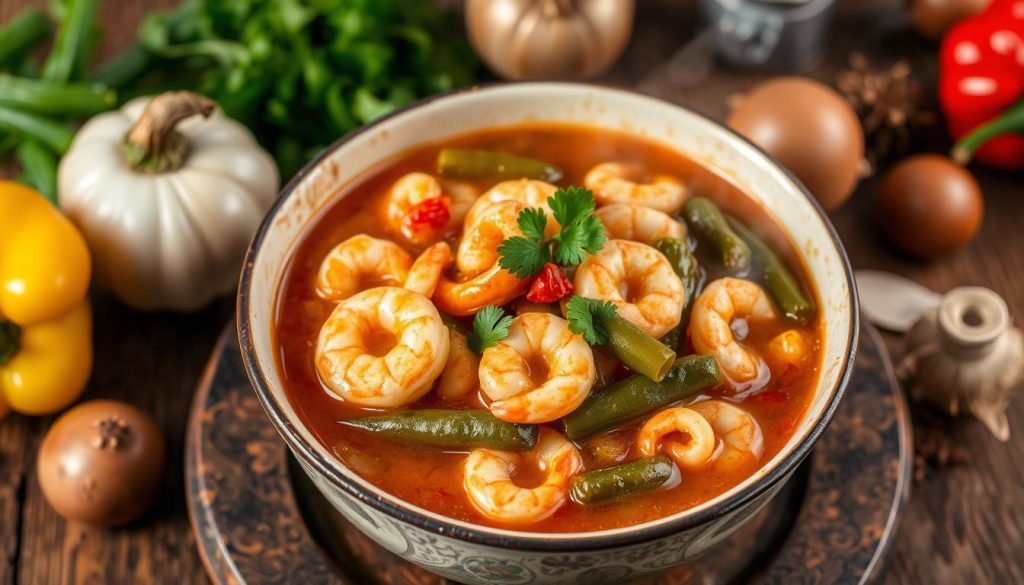
| Style | Main Ingredients | Flavor Profile |
|---|---|---|
| Cajun Gumbo | Andouille sausage, chicken, okra | Hearty, smoky, and robust |
| Creole Gumbo | Seafood, tomatoes, bell peppers | Lighter, fresher, and refined |
| Seafood Gumbo | Shrimp, crab, crawfish | Delicate and complex |
Serving Suggestions for Your Gumbo
Serving gumbo is a chance to make your meal better. You can add sides and garnishes to make it more fun. A great choice is to serve it with fluffy rice. This helps soak up the tasty broth.
Other tasty sides include potato salad. It adds a creamy touch that’s nice against the gumbo’s spicy flavors.
Traditional Accompaniments: Rice and More
Rice is a classic choice for gumbo. It soaks up the broth and adds to the gumbo’s texture. You can also add other sides to make the meal better. Here are some ideas:
- Potato salad, which offers a cool, creamy balance.
- French bread or garlic bread for dipping.
- Coleslaw for a crunchy, tangy contrast.
Garnishes to Enhance Flavor
Garnishing your gumbo makes it look and taste better. Adding fresh herbs and spices can really improve it. Here are some popular garnishes:
- Chopped green onions for a fresh burst of flavor.
- Fresh parsley to add a touch of color and freshness.
- Hot sauce for those who enjoy an extra kick.
With these tips, you can make a serving that will impress your guests. It will also make your gumbo even more delicious.
Making a Healthy Version of Gumbo
Making a healthy gumbo recipe doesn’t mean you have to give up taste. With a few smart substitutions, you can enjoy a lighter gumbo. It will keep the rich flavors that make this dish so beloved.
Substituting Ingredients for a Lighter Dish
To make a lighter gumbo, choose leaner proteins. Use chicken breast instead of thighs and turkey sausage to cut down on fat. Cassava flour is a great gluten-free thickener.
Reduce oil in the roux. This way, you get that deep amber color without too many calories.
Reducing Sodium and Fat without Sacrificing Flavor
Make a low-sodium gumbo by picking low-sodium chicken broth. Add fresh herbs for extra flavor. Onions, celery, and bell peppers, known as the Holy Trinity, add depth without extra fat.
Diced tomatoes boost flavor and keep the gumbo moist. This way, your gumbo stays tasty and fulfilling.
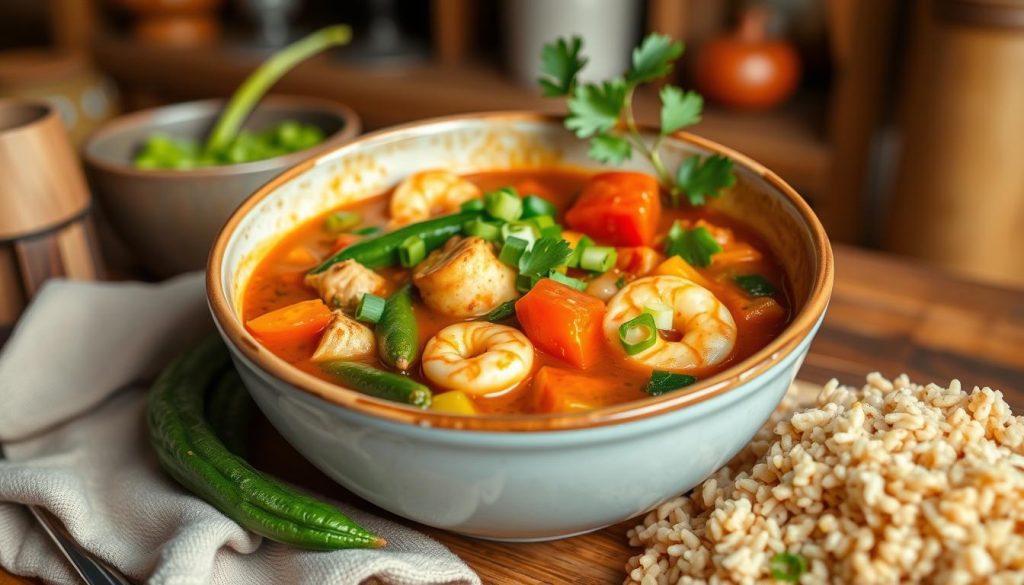
Gumbo with Okra Recipe: Cooking Tips and Tricks
Storing and reheating gumbo can make your meals better. You can enjoy your gumbo for days with the right methods. Freezing gumbo is key to keeping its taste and texture.
Storing and Reheating Leftovers
Leftover gumbo should be refrigerated to stay fresh. You can keep gumbo in the fridge for up to five days. When reheating, add low-sodium chicken broth to keep it moist.
Freezing Your Gumbo for Later Enjoyment
Freezing gumbo is great for saving it for later. Use airtight containers to keep it fresh. Don’t add seafood before freezing to keep it fresh longer.
Try to eat frozen gumbo within 2–3 months for the best taste. Learning how to freeze gumbo right lets you enjoy it later without losing flavor.
Conclusion
The classic gumbo with okra recipe captures Louisiana’s culinary spirit. It’s a mix of flavors that invites you to enjoy every bite. It’s quick to make, with just 5 minutes of prep and 25 minutes of cooking.
This dish is not only tasty but also healthy. It’s packed with spices, proteins, and okra, making it great for any diet. It’s a perfect choice for a quick, satisfying meal.
Gumbo is versatile, allowing you to try different proteins and vegetables. You can add mushrooms and zucchini to make it even better. It’s a meal that brings people together, making it perfect for sharing.
Creating your own gumbo is special. It’s a way to connect with tradition and share moments with loved ones. Enjoy making and sharing this dish to create lasting memories.
Source Links
- Okra Gumbo Recipe
- Authentic New Orleans Style Gumbo – Tastes Better From Scratch
- The Real Story of Gumbo, Okra, and Filé
- A Short History of Gumbo | Southern Foodways Alliance
- This Authentic Cajun Chicken Gumbo Recipe Is the Ultimate Comfort Food
- Seafood and Okra Gumbo
- Shrimp And Okra Gumbo Recipe – Tasting Table
- Shrimp, Andouille Sausage and Okra Gumbo — Cooks Without Borders
- Authentic Cajun Gumbo Recipe
- Creole Okra Gumbo – Melissa Cookston
- New Orleans Shrimp Sausage Gumbo
- Cajun Gumbo With Chicken and Andouille Sausage Recipe
- Smothered Okra For Gumbo • Louisiana Woman Blog
- Healthy Authentic Seafood Gumbo (Gluten Free, Whole30, Paleo, Low Carb)
- Shrimp Okra Gumbo Recipe: Made With Smothered Okra • Louisiana Woman Blog
- chicken gumbo with okra – glebe kitchen
- Quicker Chicken and Okra Gumbo Recipe
- Shrimp & Okra Gumbo
- Okra Gumbo (in Instant Pot) | Kitchen Nostalgia
- Notes from a Gumbo Road Trip – 64 Parishes
- For entertaining, gumbo’s a major player
